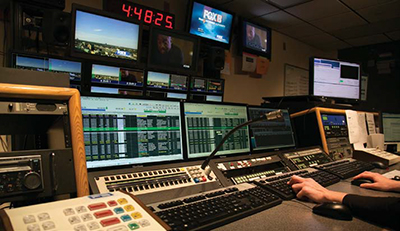Master Control Is the New Data Control
WVUE FOX8, New Orleans, uses Florical’s Acuitas channel-in-a-box system. ALEXANDRIA, VA.—Many stations are moving from automating legacy infrastructure to station-in-a-box designs but most are somewhere in between. Few share many technical similarities. Technical individuality is the challenge that makes this industry interesting. Every station’s system is better than their competitors, or it will be next year if you ask them. Every station’s disaster recovery plan is unique. And “unique” is one of the few attributes all stations have in common.

LOCAL TRENDS
“In the United States the vast majority of television stations have automation and video servers at some level,” said Shawn Maynard, vice president and general manager for Florical in Gainesville, Fla. “Not all are taking advantage of the full capabilities of full automation but most have some level integrated into their workflow.”
Jason Salyards, Harris Broadcast’s product line manager for automation noted the recent wave of mergers. “A wave of consolidation seems to be happening again,” he said. “Groups are getting larger and automation and centralcasting are an operational necessity.”
For Ross Video, the focus is on production automation more than facility automation. Allan Pepper, marketing product manager for the Iriquois, Ontario-based company says that the automation landscape is varied.
“What does differ is the level of automation from site to site, with many sites still opting to run elements of their production manually, such as audio or graphics, even when automating production switcher and server playback,” he said. “While the trend is towards more automated workflows, it remains important to provide a modular solution that can adapt to the level of automation desired.”
Overall, automation is headed in two directions at once: Some stations are centralcasting at some level or moving toward it. For other local stations, anything more than local centralcasting isn’t in the foreseeable future.
CENTRALCAST STYLES
Maynard notes three different styles of centralcasting: central control with remote storage, central control with central storage, and shared control with shared storage. These styles, or models, have several names including hub and spoke, and “sharecasting.” Salyards counts about eight ways to centralcast, pointing out that the term “can describe two stations under one roof to dozens scattered across the country.”
Get the TV Tech Newsletter
The professional video industry's #1 source for news, trends and product and tech information. Sign up below.
The complication of monitoring and controlling channels that have local live news and a transmitter hundreds of miles away introduces a whole set of different needs than a local multi-channel playout facility.
Like the many self-designed local TV stations they own, most broadcast groups have their own centralcasting workflows and models that work best for them. Practical opportunities to pool resources and reduce operating costs in more than one or more departments are always welcome.
PARTLY CLOUDY
Are stations embracing the cloud? Maynard wouldn’t admit that cloud storage is the ultimate answer, but instead believes the cloud “is one answer that will make sense to some and no sense to others. As with all emerging technology the application for use will evolve over time. I believe it has a place in broadcasting and should be explored.”
Salyards thinks the term “cloud” is as broad as centralcasting. “The cloud is more of an IT datacenter,” he said. “One successful use of the public cloud for broadcasters is for high-demand transcoding.” Private clouds are generally more attractive to broadcasters.
Many of the basic functions of master control rooms have been automated for years. What’s changing is what else can automated in harmony with it. Most master control automation systems provide hands-free automated digital ingest. Most do not control satellite dishes or IRDs, while others integrate their software with third party satellite control software such as CompuSat.
QUALITY AND REMOTE CONTROLS
Quality control has never been more critical. DVRs allow advertisers to easily monitor ad airplay. Logging recorders document discrepancies, and while the daily discrepancy report isn’t obsolete, everyone can now review what happened.
Some stations are less likely to adapt unattended operation than others, but most would agree there are times when it might make sense. Smaller market stations without live news, some with automated live news, LPTV stations, local government cable channels and some overnight TV broadcasts in many markets are taking advantage of the opportunity.

Shawn Maynard One fairly recent attractive attribute of some unattended automation systems is the ability to be controlled remotely by a web-based mobile device. The interface and how deep it can drill depends on the manufacturer, but having the ability to resolve problems without a 3 a.m. trip to master control can prove handy.
Disaster recovery is built into each automation system differently, based upon the station’s unique requirements.
NEW TRENDS
In the future, Maynard believes that there will be more centralized tools for managing multiple remote stations dynamically. “Cloud storage and SaaS are emerging technologies that automation companies are exploring,” he said. “The exciting opportunity will be true broadcast quality IP playout of material from content stored in the cloud. This will be a game changer for networks.”
Salyards describes cloud-based IP playout as “data center playout.” Since a datacenter uses generic IT hardware, servers or blade-based technology to replace infrastructure, “one of the many benefits of datacenters is elasticity in operations,” meaning the ability for up-down scalability, Salyards said. “Idle equipment doesn’t make any money.”
Ross Video’s Pepper looks at trends from a different perspective. “There is a desire to include more and more aspects of studio control in the production control system,” he said. “This often includes running effects on monitor walls and displays, and needing to control lighting systems. There is also a focus on multi-studio production with more sites striving to get as much reuse as possible out of existing production space and equipment.”
